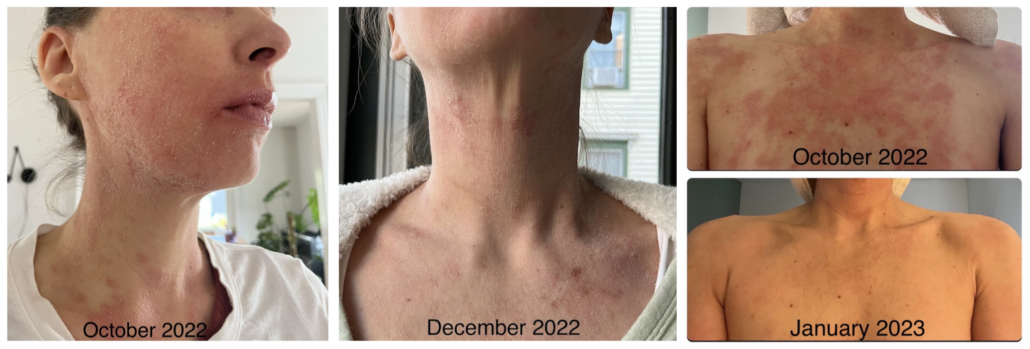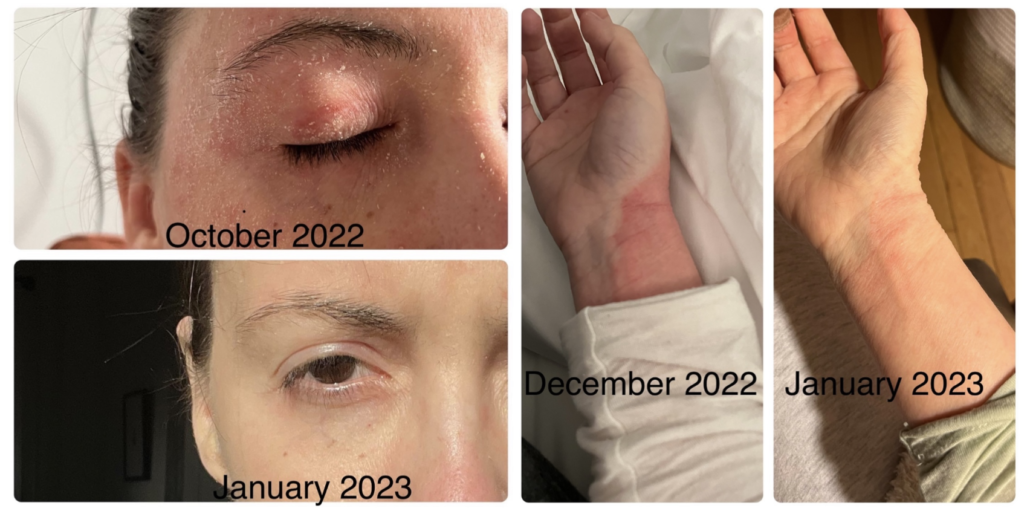Alicia’s Story – Five Months Topical Steroid Withdrawal

One snowy morning in 2022, I woke up with a swollen, red, burning face, tingling all over my body, and nausea. As someone with lifelong eczema and allergies, unexplained rashes were nothing new to me, but the systemic symptoms gave me pause. I called a local dermatologist and due to snow closures, I had a phone consultation. He diagnosed me with contact dermatitis and prescribed topical and oral steroids. Within 24 hours of taking the first dose of prednisone, my symptoms subsided. As a 25 year user of topical steroids for eczema, with long and short courses of oral steroids here and there, I considered them miracle drugs–this was no exception.
After I finished the course of steroids, the rash came back, so I had a patch test to determine my triggers. A patch test is where a dermatologist or allergist places common cosmetic ingredients on a patient’s back for four to five days to see what they react to. The test confirmed the immunosuppressant and topical steroids I had been using for years contained ingredients I was sensitive to: propylene glycol and dimethylaminopropylamine (DMAPA).
My partner and I spent hours clearing the house of anything that contained these two chemicals – shampoos, conditioners, soaps, lotions, medications, and even certain foods were donated or tossed. I spent too long at the grocery store checking the ingredients of every item I wanted to buy to ensure it wouldn’t harm me. I started washing my hair with apple cider vinegar and washing my face with oatmeal.
Despite my efforts, my symptoms went from three to ten. Every night before bed, my face, hands, and ears went bright red and felt like they were on fire. My body broke out in unexplained hives and discoid eczema (one of the few subtypes of dermatitis I had never experienced before).

I began showing indications of circulation problems (mottled skin and Raynaud’s). I was frightened – my symptoms were getting worse despite using the topical steroids as prescribed. I was told it was okay to keep using them until the rashes disappeared and I was flying through tubes of topical steroids. There was no red flag issued about the amount of refills I requested and, instead, I was prescribed a tub of more potent medication so the doctor did not have to keep calling the pharmacy. My dermatologist diagnosed me with seborrheic dermatitis and rosacea. He sent me off with a topical prescription to treat the rosacea. It made things even worse. I developed pustules all over my face, my hands and ears flushed redder and hotter, hives began showing up on my face and body, and my circulation problems continued to get worse. I’d wake up with one limb numb even though it wasn’t the limb I was sleeping on. I discontinued the rosacea treatment, but aside from the pustules on my face, every other symptom continued. Unfortunately, new and odder manifestations such as rashes that resembled acne on my neck, back, and arms also showed up.
Not getting the answers I needed, I decided to see an allergist. He sat at a big wooden desk, with a medical scribe by his side, and asked me to tell him my health story from birth to present. I took him through my history and relayed what had happened recently. He immediately recognized that something was wrong and assumed it was autoimmune. I was sent down the hall for skin prick allergy tests and 22 blood and urine tests to rule out everything from rare diseases to general inflammation.
Results from the skin prick allergy tests indicated environmental triggers included mold, dog, and just about every tree (the latter explained my yearly springtime suffering), and I began sublingual immunotherapy to treat my allergies. My lab results, on the other hand, came back normal, except for elevated IgE. Six months into spreading rashes on my face and upper body, numbness, tingling, and cycling red hot areas of the skin, I hit a breaking point. With ten doctors’ appointments behind me, I was still sick, and I found myself bedridden on a beach vacation – nauseated, with bright red, burning circular patches on my cheeks.
I called a dermatologist I used to see in New York City to make an appointment. A month later, in his office, I showed him ten photos of my face over the year and described my symptoms. He immediately said, “You have Topical Steroid Addiction.” Though I didn’t know much about Topical Steroid Addiction and Topical Steroid Withdrawal, it was the first diagnosis I had in a year that made sense to me. He spent over 30 minutes with me, walking me through what I might expect and how I can treat the symptoms. “Withdrawing will be horrible, but you will get better, and you will probably have beautiful skin when you are healed.”
Naturally, I did a lot of research when I got home. That’s when I discovered ITSAN (The International Topical Steroid Awareness Network), and found out that for some patients, topical steroids, which were once a miracle for painful, itchy skin, eventually become less effective and patients describe developing new, spreading rashes. These worsening rashes are often mistaken for eczema, contact dermatitis, rosacea, or an allergic reaction.
I became terrified of the uncertainty – of how long I might be bedridden, whether I’d be able to keep working, and if I would feel disconnected from my body, partner, family, and friends. The day I went off the steroids, my face seemingly exploded. My eyes swelled and my entire face went bright red, like I was burning from the inside out. Within days, the red, scaly patches spread to my chest, my hands, and my arms. Then, my jawline began peeling and scabbing. This gave way to excessive exfoliation over my entire body – shedding so much skin I had to sweep up after myself.
My worst symptom in those beginning months was the inability to regulate my temperature. I felt as if I had sun poisoning with burning, shivering, and night sweats. I began experiencing sleep disturbances and hair loss along with nerve pain and bone deep itch.
I am at month five of TSW. I know they say healing is not linear, but some aspects of it have been for me. Each flare is shorter and less intense. My mental health has significantly improved. When I look at photos from the first month or two, I am shocked at how bad it was – as if I was out of body in the early days.
I just returned from my first vacation and it was incredible! I ate whatever I wanted, wore jeans the entire time (if you know, you know), and did not flare once. It was incredible for my skin and my soul. Like most people during TSW, I have tried a lot of things to ease my suffering.

What has not helped me:
- Acupuncture and Traditional Chinese Medicine (TCM) – I tried this in the very early days and it led to flares. Many have had success, but it did not help me.
- Low Dose Naltrexone (LDN) – this was the most detrimental treatment I attempted. My night sweats became impossible to manage. Most significantly, I was unable to sleep for even a minute. My mind became so dark, I was unable to see the light. Within 24 hours of going off the medicine, I was able to sleep and find hope again.
- Zinc Wraps – man oh man did these make me flare!
What has helped me:
- Allergy patch testing, skin prick allergy tests and sublingual immunotherapy in the year leading up to my diagnosis. Removing triggers prior to going through TSW has made it much easier for me to determine what is triggering me now (i.e., I now know it’s not my shampoo, but the fireplace in a hotel room).
- Red light therapy and Doxycycline – when my dermatologist diagnosed me, he recommended I take up red light therapy and he gave me a low dose of Doxycycline (an antibiotic) to help with inflammation over the first few months. Although antibiotics are controversial in the eczema community, and I am no longer on them, I credit this with my quick progress. A quality probiotic during this time was key.
- Advil and Cannabis Chews – both help me sleep. Advil helps with the itch/inflammation on tougher days and cannabis chews help me sleep.
- Modal fabric – when I was diagnosed, I bought a bunch of comfy clothes, all made of modal fabric. I can’t wait to never wear these clothes again, but they have been such a help.
- Specific Supplements – Vitamin D, Vitamin B, flax oil, and 500 mg of taurine. Taurine made my red sleeves dissipate within days!
- Dead Sea Salt, Coconut Oil Baths, Zinc Cream, Apple Cider Vinegar, Vaseline, Unpetroleum Jelly, and Castor Oil – I’ve used each of these items at various stages and in some stages, used nothing. If there is anything I have learned about products it’s that we are all different. What helps one person may hurt another.
- Protein and Bone Broth – weight loss with TSW has been no joke, so adding in protein shakes has helped me to keep the weight on. In addition, eating more meat and bone broth has helped with skin healing and collagen. When I don’t do these things, it is apparent pretty quickly.
- Journaling – journaling has become my friend during TSW. I make sure to write down a few things each day that I am grateful for, even if it is a hard day.
- Mindset and Activity – I am not saying some days won’t be rough or that I don’t allow myself to feel sad and tired from the marathon of this condition. However, it’s important for me, personally, to remain hopeful each day. I exercise when I can and try to take daily walks, often in nature, which is always a great mental reset. A pedometer helps!
- Knowing my social media boundaries – I did not have social media before TSW and spent a lot of time on the boards in the early days. I have gained a great support system and learned a lot from others. However, for me, the community can also create unnecessary confusion and anxiety at times. It can also make my entire identity feel wrapped up in TSW. Knowing when to deactivate my account or disengage has been important for my mental health.
- Socializing – seeing friends and family, even when flared, is key. Getting out of the house helps me forget about my skin for a few hours and brings me joy.
- Travel – I was able to travel to California recently. I was anxious about how the flight, etc. would affect me and it ended up being the best thing I could have done for myself. The climate was great for my TSW, I spent almost no time thinking about my skin, I ate whatever I wanted, and did not experience one flare! The trip truly filled me up.
- The support of my partner, family, friends, doctor, and coworkers – I am lucky to have an incredible support system – from my partner to my doctor to my job. Most people are not diagnosed with TSW and must diagnose themselves. I am not sure I could have done this without my doctor advising me to stay the course. I am certain I could not have done it without my partner’s support – whether it has been taking me on a walk, providing kind reminders of how fast things change, or making me nourishing food.
- Listening to my body – this has been my most important lesson so far. It’s easy to get distracted by what works for other people. Listening to whether my body wanted a bath or a shower, needed rest, or something else has been critical. I stopped looking to others for what I should be trying and my skin thanked me by improving rapidly (so did my pocketbook).
TSW has changed the way I think about my skin. I’ve become more patient and I allow my body to heal on its own, rather than turning to a cream and/or medicine right away. Despite the terrible symptoms, I am glad to know I am healing.
Update – 6.5 months TSW
I’ve sadly been going through a flare for the last four weeks. I believe it was triggered by a cold, but the truth is I may have flared either way. My skin is very painful this time around and is very elephant-y, so I’ve cut back on showering/bathing and have stopped moisturizing. Some of my least favorite TSW symptoms like thermoregulation issues, hair loss (pretty intense this time), and oozing have returned. My face and neck went into full flaking mode and I am back to vacuuming the bed.
The ups and downs of this process can be really hard on a person’s mental health. I won’t pretend that some days I don’t feel sorry for myself because I do and that is okay. On those days, I try to simplify and remember that no matter what I do (stay in the house or enjoy the pollen-filled air) I may flare. This pushes me outside of my anxiety and allows me to get out of the house when I can. Recently, I began making more to-do lists and even list what I can’t do (i.e., I missed a work trip this week because I can’t travel) and workarounds for that thing (i.e., I was able to dial in to the work event and my wonderful co-workers carried a laptop around with a camera on it so I could engage with the team face-to-face like I was there in real life).
I’m finally beginning to see some improvements and softening of skin that was thickened for quite awhile. Although my neck is a hot spot for my TSW symptoms, I’ve noticed a lot more elasticity there. I don’t remember where I heard this, but I’ve been reminding myself every day that if there are a finite number of flares I will go through in TSW, I am one flare closer to being healed. We got this, fellow warriors (patients and caregivers alike)!


